engine Citroen GRAND C4 PICASSO RHD 2016 2.G Owners Manual
[x] Cancel search | Manufacturer: CITROEN, Model Year: 2016, Model line: GRAND C4 PICASSO RHD, Model: Citroen GRAND C4 PICASSO RHD 2016 2.GPages: 523, PDF Size: 13.63 MB
Page 276 of 523
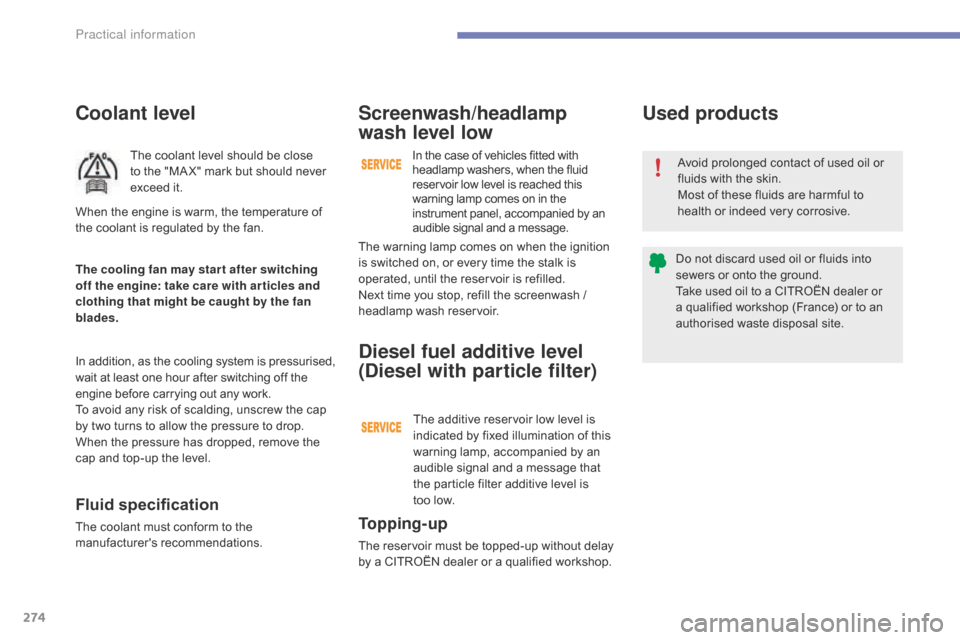
274
Coolant level
The coolant level should be close to the "MA X" mark but should never
e
xceed it.
In
addition, as the cooling system is pressurised,
w
ait
at
least one hour after switching off the
e
ngine
before carrying out any work.
To
avoid
any risk of scalding, unscrew the cap
b
y
two
turns to allow the pressure to drop.
W
hen
the
pressure has dropped, remove the
c
ap
and
top-up the level.
Fluid specification
The coolant must conform to the manufacturer's r ecommendations.
The cooling fan may star t after switching
off the engine: take care with ar ticles and
clothing that might be caught by the fan
blades. When the engine is warm, the temperature of
t
he coolant is regulated by the fan.To p p i n g - u p
The reservoir must be topped-up without delay b
y a CITROËN dealer or a qualified workshop.
Diesel fuel additive level
(Diesel with particle filter)
The additive reservoir low level is indicated by fixed illumination of this
w
arning lamp, accompanied by an
a
udible signal and a message that
t
he particle filter additive level is
t
oo low.
The
warning lamp comes on when the ignition
i
s
switched on, or every time the stalk is
o
perated,
until the reservoir is refilled.
Next
time
you stop, refill the screenwash /
h
eadlamp
wash reservoir.
Screenwash/headlamp
wash level low
In the case of vehicles fitted with h
eadlamp washers, when the fluid r
eservoir low level is reached this
w
arning lamp comes on in the
i
nstrument panel, accompanied by an
a
udible signal and a message. Avoid
prolonged contact of used oil or
f
luids with the skin.
Most
of these fluids are harmful to
h
ealth or indeed very corrosive.
Do
not discard used oil or fluids into
s
ewers or onto the ground.
Take
used oil to a CITROËN dealer or
a
qualified workshop (France) or to an
a
uthorised waste disposal site.
Used products
Practical information
Page 277 of 523
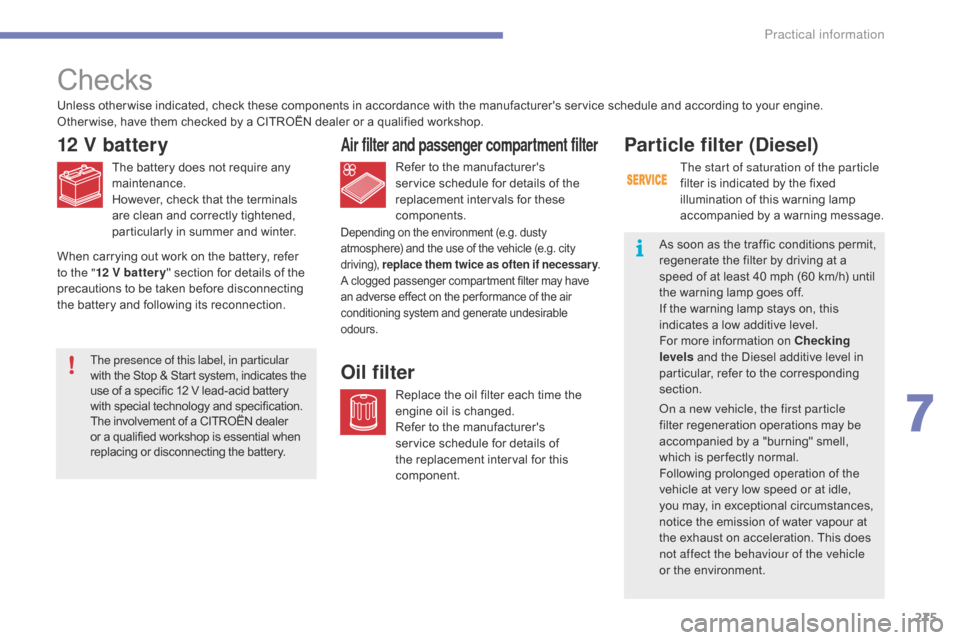
275
Checks
12 V battery
The battery does not require any maintenance.
However,
check that the terminals
a
re clean and correctly tightened,
p
articularly in summer and winter.Refer
to the manufacturer's s
ervice schedule for details of the
r
eplacement intervals for these
c
omponents.
Air filter and passenger compartment filter
Replace the oil filter each time the engine oil is changed.
Refer
to the manufacturer's
s
ervice schedule for details of
t
he replacement interval for this
c
omponent.
Oil filterThe presence of this label, in particular
with the Stop & Start system, indicates the u
se of a specific 12 V lead-acid battery
w
ith special technology and specification.
T
he involvement of a CITROËN dealer
o
r a qualified workshop is essential when
r
eplacing or disconnecting the battery.
Unless
other wise indicated, check these components in accordance with the manufacturer's service schedule and according to your engine.
Other wise, have them checked by a CITROËN dealer or a qualified workshop.
Depending on the environment (e.g. dusty a
tmosphere) and the use of the vehicle (e.g. city d
riving),
r
eplace them twice as often if necessar y .
A
clogged passenger compartment filter may have
a
n adverse effect on the per formance of the air
c
onditioning system and generate undesirable
o
dours.
Particle filter (Diesel)
The start of saturation of the particle
filter is indicated by the fixed
i
llumination of this warning lamp
a
ccompanied by a warning message.
As
soon as the traffic conditions permit,
r
egenerate the filter by driving at a
s
peed of at least 40 mph (60 km/h) until
t
he
warning lamp goes off.
If
the warning lamp stays on, this
i
ndicates a low additive level.
For
more information on Checking
levels
and the Diesel additive level in
p
articular, refer to the corresponding
s
ection.
On a new vehicle, the first particle
filter
regeneration operations may be
a
ccompanied by a "burning" smell,
w
hich is per fectly normal.
Following
prolonged operation of the
v
ehicle at very low speed or at idle,
y
ou
may, in exceptional circumstances,
n
otice the emission of water vapour at
t
he
exhaust on acceleration. This does
n
ot affect the behaviour of the vehicle
or
the environment.
When
carrying
out
work
on
the
battery,
refer
t
o the " 12 V batter y "
section
for
details
of
the
p
recautions
to
be
taken
before
disconnecting
t
he
battery
and
following
its
reconnection.
7
Practical information
Page 278 of 523
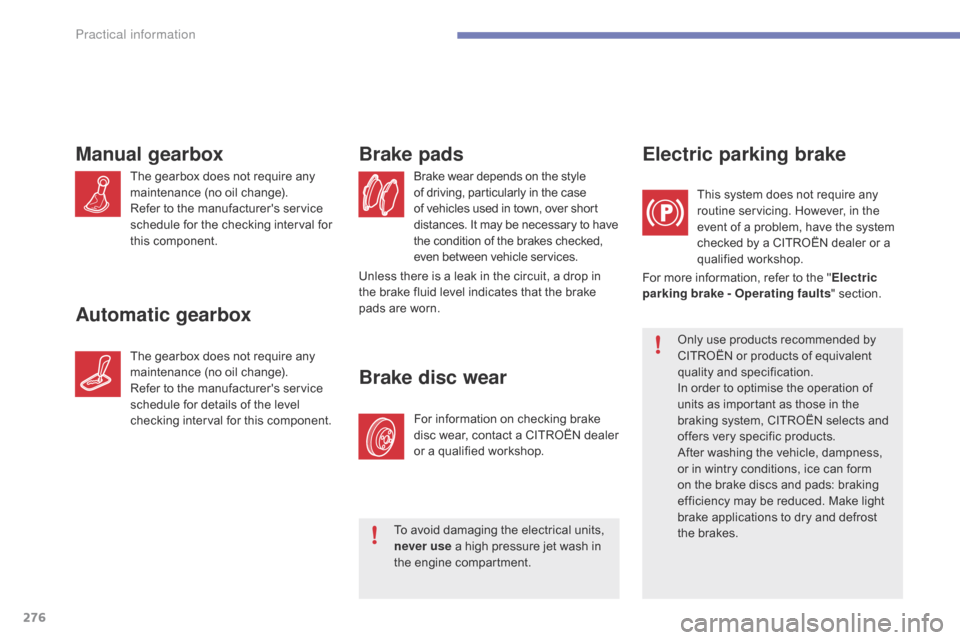
276
Brake wear depends on the style of driving, particularly in the case o
f vehicles used in town, over short
d
istances. It may be necessary to have
t
he condition of the brakes checked,
e
ven between vehicle services.
Brake pads
For information on checking brake disc wear, contact a CITROËN dealer
o
r a qualified workshop.
Brake disc wear
Only use products recommended by CITROËN or products of equivalent
q
uality
an
d
sp
ecification.
In
order to optimise the operation of
u
nits as important as those in the
b
raking system, CITROËN selects and
o
ffers very specific products.
After
washing the vehicle, dampness,
o
r in wintry conditions, ice can form
o
n the brake discs and pads: braking
e
fficiency may be reduced. Make light
b
rake applications to dry and defrost
t
he brakes.
Electric parking brake
For more information, refer to the "E lectric
parking brake - Operating faults "
section.
This
system does not require any
r
outine servicing. However, in the
e
vent of a problem, have the system
c
hecked by a CITROËN dealer or a
q
ualified
w
orkshop.
Manual gearbox
The gearbox does not require any m
aintenance (no oil change).
Refer
to the manufacturer's service
s
chedule for the checking interval for
t
his
c
omponent.
Automatic gearbox
The gearbox does not require any maintenance (no oil change).
Refer
to the manufacturer's service
s
chedule for details of the level
c
hecking interval for this component.
To
avoid damaging the electrical units,
n
ever use a high pressure jet wash in
t
he engine compartment.
Unless
there is a leak in the circuit, a drop in
t
he brake fluid level indicates that the brake
p
ads are worn.
Practical information
Page 279 of 523

277
AdBlue® additive and SCR system
f
or
BlueHDi Diesel engines
To assure respect for the environment and c
onformity with the new Euro 6 emissions
s
tandard, without adversely affecting the
p
er formance or fuel consumption of Diesel
e
ngines, CITROËN has taken the decision to
e
quip its vehicles with an effective system that
a
ssociates SCR (Selective Catalytic Reduction)
w
ith a particle filter (FAP) for the treatment of
e
xhaust gases.
Presentation of the SCR system
Using a fluid called AdBlue® containing urea, a c
atalytic
converter
turns
up
to 85% of nitrogen
o
xides
(NOx)
into
nitrogen
and water, which are
h
armless
to
health
and
the
environment. The
AdBlue
® additive is held in a special t
ank
located
under the boot at the rear of
t
he
vehicle.
It has a capacity of 17 litres: this
p
rovides
a
driving range of about 12 500 miles
(
20
000
km),
after which an alert is triggered
w
arning
you
when the reserve remaining is
e
nough
for
just 1 500 miles (2 400 km).
During
each
scheduled service of your vehicle
b
y
a
CITROËN dealer or a qualified workshop,
t
he
AdBlue
® additive tank is refilled in order to a
llow
normal operation of the SCR system.
If
the
estimated mileage between two services
i
s
greater
than 12 500 miles (20 000 km), we
r
ecommend
that you go to a CITROËN dealer
o
r
a
qualified workshop to have the necessary
t
op-up
carried out. Once
the AdBlue
® tank is empty, a s
ystem
required
by regulations
p
revents
starting
of the engine.
If the SCR
is faulty, the level of
emissions
from
your vehicle will no
l
onger
meet
the
Euro 6 standard: you
v
ehicle
becomes
polluting.
In
the
event
of
a
confirmed fault
w
ith
the
SCR
system, you must go
t
o
a
CITROËN
dealer or a qualified
w
orkshop
as
soon as possible: after
a
running
distance of 650 miles
(
1 100
km),
a
system will be triggered
a
utomatically
to
prevent engine starting.
7
Practical information
Page 281 of 523

279
Recommendations on storage
AdBlue® freezes at about -11°C and d
eteriorates above 25°C. It is recommended
t
hat
bottles be stored in a cool area and
p
rotected from direct sunlight.
Under
these conditions, the fluid can be kept
f
or
at
least a year.
If
the
additive has frozen, it can be used once it
h
as
completely thawed out.
Procedure
Before topping-up, ensure that the vehicle is parked on a flat and level sur face.
In
wintry conditions, ensure that the
t
emperature of the vehicle is above -11°C.
O
ther wise, by freezing, the AdBlue
® cannot
be
poured
into
its
tank.
Park
your
vehicle in a
w
armer
area
for
a
few
hours
to
allow the top-up
t
o
be
carried
out.
F
P
ress
the
START/STOP
button
to switch
o
ff
the
engine. F
F or access to the AdBlue® tank, raise the b
oot
floor,
or
on
7-seat
versions, unfold the
r
ight
hand
seat
in
the
third
row.
Never
store
bottles
of
AdBlue
® in your
vehicle.
F
W
ithout pressing, turn the black cap a
q
uarter turn anti-clockwise and lift it off.
F
T
urn the blue cap a 6
th of a turn anti-
c
lockwise.
F
L
ift
off
the
cap.
F
O
btain
a
bottle
of
AdBlue
®. After first c
hecking
the
use-by
date,
read carefully
t
he instructions on use on the label before
pouring
the
contents
of
the bottle into your
v
ehicle's
Ad
Blue
® tank.
7
Practical information
Page 282 of 523
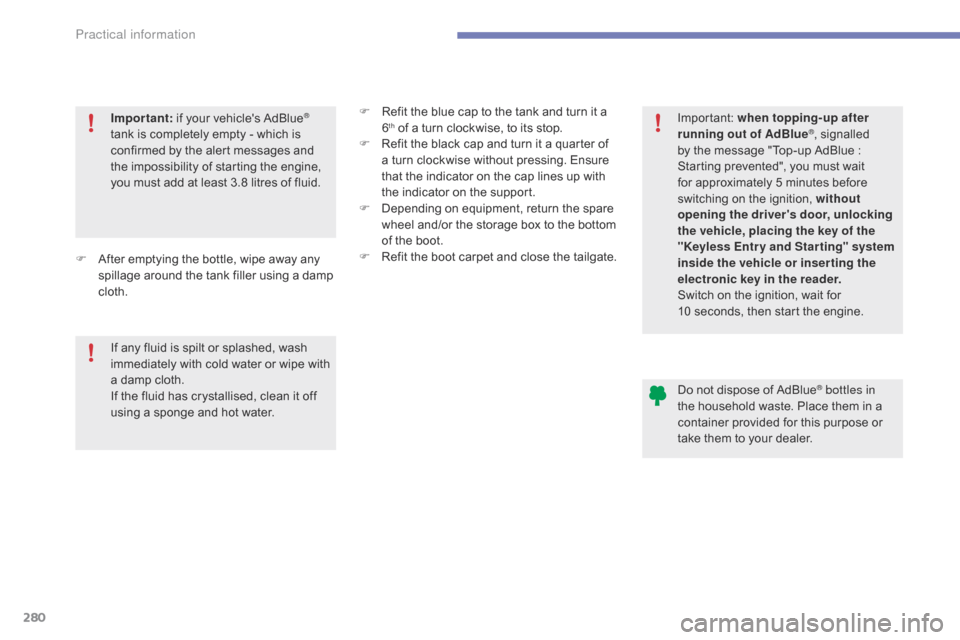
280
Important: if your vehicle's AdBlue®
tank
is
completely
empty
-
which
is
c
onfirmed
by
the
alert
messages
and
t
he
impossibility
of
starting
the
engine,
y
ou
must
add
at
least
3.8
litres
of
fluid. Important: w
hen topping-up after
running out of AdBlue®, signalled b
y
the
message
"Top-up
AdBlue :
S
tarting
prevented",
you
must wait
f
or
approximately
5
minutes before
s
witching
on
the
ignition,
without
opening the driver's door, unlocking
the vehicle, placing the key of the
"Keyless Entr y and Star ting" system
inside the vehicle or inser ting the
electronic key in the reader.
Switch
on
the
ignition,
wait for
1
0 seconds,
then
start
the engine.
If
any
fluid
is
spilt
or
splashed,
wash
i
mmediately
w
ith
c
old
w
ater
o
r
w
ipe
w
ith
a
damp
cloth.
If
the
fluid
has
crystallised,
clean
it
off
u
sing
a
sponge
and
hot
water.
F
A
fter
emptying
the
bottle,
wipe
away
any
s
pillage
around
the
tank
filler
using
a
damp
c
loth. F
R
efit
the
blue
cap
to
the
tank
and
turn
it
a
6th of a turn clockwise, to its stop.
F
R
efit the black cap and turn it a quarter of
a
turn clockwise without pressing. Ensure
t
hat the indicator on the cap lines up with
t
he indicator on the support.
F
D
epending on equipment, return the spare
w
heel and/or the storage box to the bottom
o
f
the boot.
F
R
efit the boot carpet and close the tailgate.
Do
not dispose of AdBlue
® bottles in
the
household
waste.
Place them in a
c
ontainer
provided
for
this
purpose or
t
ake
them
to
your
dealer.
Practical information
Page 286 of 523
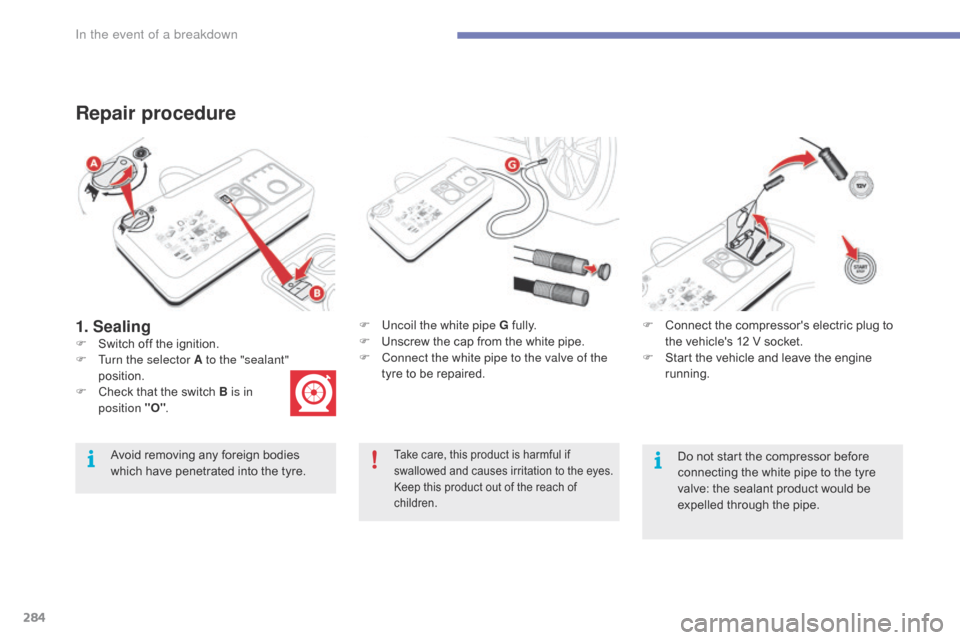
284
1. Sealing
Repair procedure
Avoid removing any foreign bodies which have penetrated into the tyre.F
U
ncoil the white pipe G
f
ully.
F
U
nscrew the cap from the white pipe.
F
C
onnect the white pipe to the valve of the
tyre to be repaired.
F
S
witch off the ignition.
F
T
urn the selector A to the "sealant"
position.
F
C
heck that the switch B is in
position "O" . F
C
onnect the compressor's electric plug to
t
he vehicle's 12 V socket.
F
S
tart the vehicle and leave the engine
r
unning.Take care, this product is harmful if s
wallowed and causes irritation to the eyes.
Keep
this product out of the reach of
c
hildren.Do not start the compressor before c onnecting the white pipe to the tyre
v
alve: the sealant product would be
e
xpelled through the pipe.
In the event of a breakdown
Page 290 of 523
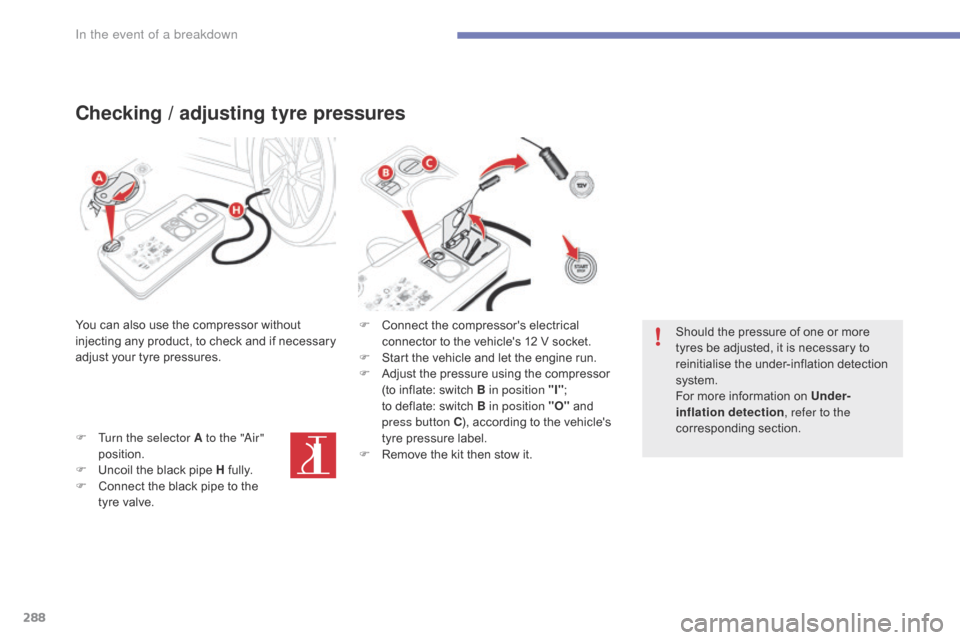
288
Checking / adjusting tyre pressures
You can also use the compressor without injecting any product, to check and if necessary
a
djust your tyre pressures.
F
T
urn the selector A to the "Air"
position.
F
U
ncoil the black pipe H
f
ully.
F
C
onnect the black pipe to the
t
yre valve. F
C onnect the compressor's electrical
c
onnector to the vehicle's 12 V socket.
F
S
tart the vehicle and let the engine run.
F
A
djust the pressure using the compressor
(
to inflate: switch B in position "I";
t
o deflate: switch B in position "O"
and
p
ress button C),
according to the vehicle's
t
yre pressure label.
F
R
emove the kit then stow it.Should
the pressure of one or more
t
yres be adjusted, it is necessary to
r
einitialise the under-inflation detection
s
ystem.
For
more information on Under-
inflation detection , refer to the
corresponding
s
ection.
In the event of a breakdown
Page 314 of 523
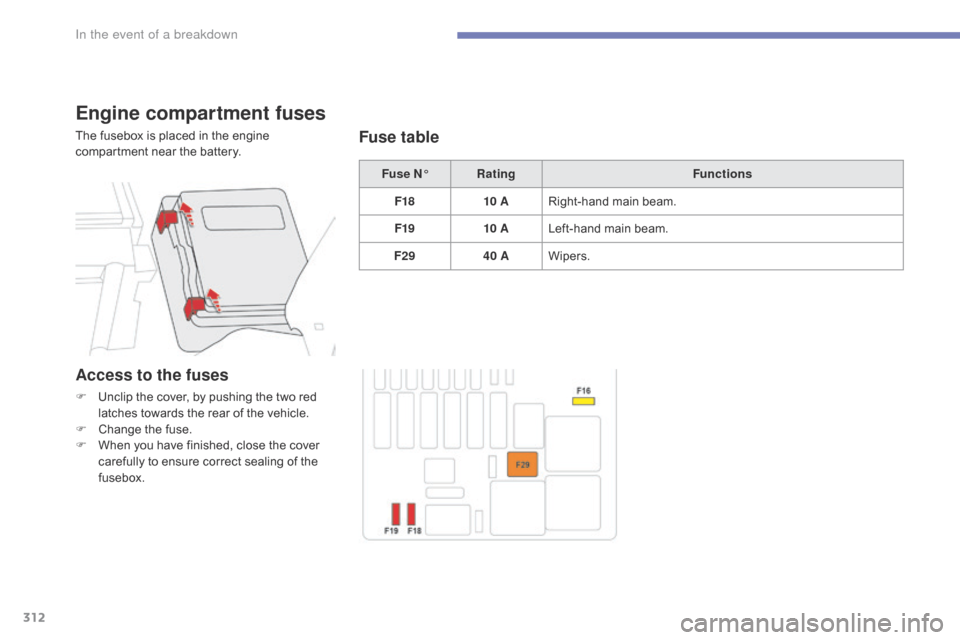
312
Engine compartment fuses
The fusebox is placed in the engine compartment near the battery.
Fuse N°Rating Functions
F18 10 ARight-hand
main beam.
F19 10 ALeft-hand
main beam.
F29 40 AWipers.Fuse table
Access to the fuses
F Unclip the cover, by pushing the two red l
atches towards the rear of the vehicle.
F
C
hange the fuse.
F
W
hen you have finished, close the cover
c
arefully to ensure correct sealing of the
f
usebox.
In the event of a breakdown
Page 315 of 523

313
12 V battery
The battery is located under the bonnet.
F or access to the (+) terminal:
F
r
elease the bonnet using the interior lever,
t
hen the exterior safety catch,
F
r
aise the bonnet and secure it with its stay,
F
l
ift the plastic cover for access to
the (+) terminal.
Access to the battery
Procedure for starting the engine using another battery or charging a discharged battery.
P rotect your eyes and face before
h
andling the battery.
All
operations on the battery must be
c
arried out in a well ventilated area and
a
way from naked flames and sources
o
f sparks, so as to avoid the risk of
e
xplosion or fire.
Wash
your hands after wards.
Versions
equipped with Stop & Start are
f
itted with a 12 V lead-acid battery of
s
pecific
t
echnology
a
nd
s
pecification.
Its
replacement should be carried out
o
nly
by
a
CITROËN
dealer
or
a
qualified
w
orkshop.
Batteries
contain harmful substances
s
uch as sulphuric acid and lead.
They
must be disposed of in
a
ccordance with regulations and must
n
ot, in any circumstances, be discarded
w
ith household waste.
Take
used remote control batteries and
v
ehicle batteries to a special collection
point.
General points
Lead-acid starter batteries
If your vehicle has an automatic g earbox, do not try to start the engine
b
y pushing the vehicle.
The
(-) battery terminal is not accessible.
A r
emote earth point is located at high level
u
nder the bonnet (alongside the battery).
8
In the event of a breakdown